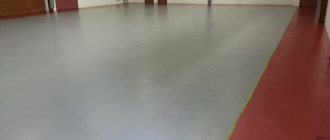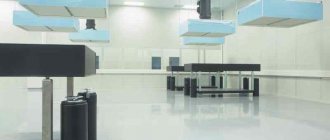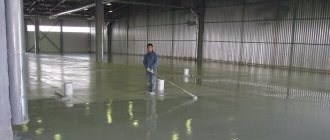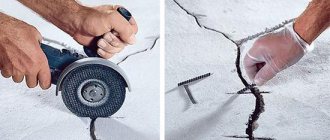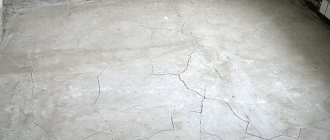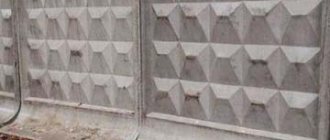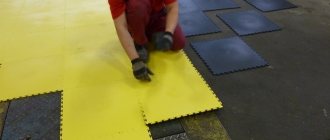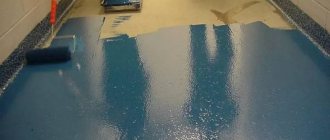Any foundation requires the creation of protection so that its service life is extended. Concrete material is no exception; this is usually achieved by painting. But it is important to choose high-quality paint and varnish material. A similar product can be called polymer paint for concrete. The features of the paint, the rules for its selection and use will be discussed in detail below.
Why paint concrete
Concrete material is durable; if the floor covering is created correctly, it will be reliable and wear-resistant. But under the influence of environmental factors, sometimes the surface becomes covered with cracks, and as a result, cement dust is formed.
This dust is harmful to humans, can cause allergies and damage mucous membranes. The cold from concrete can cause colds. Dust can also cause harm to various equipment if it penetrates inside.
To prevent dust from appearing, the base is sanded and then painted.
Also dangerous to concrete are various chemicals that are actively used in garages, technical buildings, etc. Staining also helps achieve an aesthetically pleasing floor design.
Staining also helps achieve an aesthetically pleasing floor design.
Advantages of painting a concrete floor: feasibility of the procedure
Concrete is a conglomerate. It includes a number of elements that have different states of aggregation and chemical composition. This explains its porous structure, which also includes solid components. Some tiny pores are filled with a gel-like cementitious substance that has a viscous consistency. The remaining capillaries and cavities contain air or water, which remained unbound during the hydration process or simply got there from the outside.
A painted concrete floor does not generate dust, and it also becomes stronger and more durable.
This material structure creates favorable conditions for erosion. This process is especially active in those areas where the screed is exposed to mechanical stress, exposure to aggressive chemicals and negative environmental factors. It is under such conditions that concrete floors are used in garages, workshops, technical and utility rooms.
Without floor paint, a concrete base quickly becomes unusable:
- strength characteristics decrease;
- the surface is very dusty;
- cavities and cracks appear;
- the coating crumbles;
- some areas become unstable.
Floor paints for concrete floors have good penetrating ability. Getting into the structure of the material, they “seal” the voids, preventing moisture and chemically active substances from entering them. After painting, a thin film is formed on the surface of the screed. Thanks to its wear resistance, it protects floors from premature abrasion.
Advantages of painting concrete:
Without painting, a concrete floor very quickly becomes unusable.
- Surface properties such as strength and wear resistance are improved.
- The possibility of dusting is completely eliminated.
- A waterproofing coating is formed on the surface, protecting the floors from the penetration of moisture, chemically active substances and petroleum products.
- The service life of the concrete base increases.
- It becomes possible to reduce the overall cost by using cement mortars of a lower grade, without compromising the performance of the coating.
- The process of caring for floors is simplified.
- The colors of floor paints are quite varied, which allows you to improve the decorative qualities of the concrete screed and create a beautiful design.
Note! Any paintwork will have to be updated from time to time. However, the cost of such an event is much less than a deep restoration of a concrete floor or its refilling.
What paints are used to coat concrete?
To create a floor covering, polymer paint for a concrete floor is selected. There are different types of these paints, they differ in the material used in the base.
To determine which option is best suited, you need to know what loads are encountered during operation. After all, coatings have different levels of protection and technical characteristics. Additionally, primers and impregnations can be used.
To create a floor covering, polymer paint for a concrete floor is selected.
How to paint concrete floors: main types of compositions
Paint intended to protect concrete must have certain properties. If you want to get a really high-quality coating, you won’t be able to simply limit yourself to a cheap oil composition. It will not provide adequate surface strength or protection. Its use, on the contrary, can provoke faster destruction of the material.
For these purposes, it is better to use polymer paints for concrete floors:
- acrylic;
- rubber;
- urethane;
- epoxy;
- polyurethane.
A variety of polymer compositions are suitable for painting concrete floors.
Each type of composition has certain characteristics, advantages and disadvantages, as well as special operating conditions. All these nuances must be taken into account when choosing a dye for floors.
Characteristics of acrylic paints for concrete floors
To produce this type of dyes, acrylic resins are used, as well as pigments of organic and inorganic origin. They are made on the basis of polyacrylates and acrylates in combination with components that form a protective coating. The composition may also contain esters, which provide rapid drying and resistance to moisture.
Many manufacturers claim that just one application is enough for a high-quality result. However, as practice shows, you still need at least two layers. The consumption of acrylic dyes is about 0.1-0.2 l/m². These compounds are ideal for treating small areas.
The main areas of application of acrylic paints for floors:
- garages;
- basements;
- balconies.
Acrylic paints are suitable for floors on balconies, garages and basements
Acrylic-based compositions are resistant to short-term exposure to non-aggressive chemicals and moisture. You can find many colors and shades on sale. Using acrylic dyes, both matte and glossy finishes are obtained. Plain water acts as a solvent. This dye option is one of the most affordable. Acrylic compounds fall into the category of odorless and quick-drying floor paints. They dry out in about 12 hours. You can walk freely on such a surface after 48 hours.
Advantages of acrylic-based dyes:
- environmental friendliness;
- safety;
- resistance to moisture;
- increasing the strength characteristics of the treated surface;
- resistance to high temperatures;
- durability.
Helpful advice! Acrylic paints are best used on second floors, if any, or in dry basements. It is not recommended to use them as a base coat.
Features of acrylic-silicone wear-resistant floor paints
These products are made from silicone resins and acrylic copolymers. Acrylic-silicone enamels belong to the category of wear-resistant compounds. This type of two-component concrete floor paint combines all the benefits of silicones and acrylics. These elements form a coating with a special structure, which has high strength and resistance to various types of mechanical loads. In addition, acrylic-silicone enamels do not have favorable conditions for the development of harmful bacteria.
Acrylic-silicone paints are characterized by increased wear resistance
Acrylic resins have excellent adhesive properties, so the paint adheres well to the concrete base. At the same time, the coating is quite elastic. This property is ensured due to the presence of silicone resins in the composition. They are substances of polymer origin. Due to silicon, the coating is quite durable. Silicone resins have another useful quality - electrostaticity. Thanks to this property, the surface repels dust.
Acrylic-silicone enamels have many advantages and only one drawback. The color range of these dyes is very limited. The composition is applied to the concrete surface in at least two layers. Before you start repainting, you need to wait until the first layer dries. This requires at least 3 hours.
Concrete floor repair: features of the restoration process and complete replacement of the screed
Classification and selection of mixtures. Features of the work. Cost of repair work. Recommended compositions.
Benefits of epoxy paints for concrete floors
Epoxy compounds for concrete surfaces are two-component dyes that must be mixed before use. This must be done very carefully to achieve a homogeneous mass. Water can be used as a solvent. The color range of epoxy compositions is small, however, in comparison with the numerous advantages of this wear-resistant paint for concrete floors, this disadvantage can be ignored.
Epoxy enamels are highly resistant to abrasion and wear. After drying, the paint turns into a durable and durable coating, so it can even be used for treating floors in industrial premises. Epoxy mixtures can withstand significant mechanical loads. They are not afraid of the negative influence of various atmospheric factors, so they are suitable for use in open spaces.
Epoxy paints are resistant to temperature changes
Advantages of epoxy floor paints:
- high resistance to moisture;
- excellent adhesive properties (subject to preliminary degreasing of the surface);
- high degree of protection against the effects of various chemicals (alkalis, acids, oils, salt solutions);
- the color remains durable for a long time, does not fade or change.
Note! Epoxy dyes are applied in at least two layers with a break of at least 12 hours.
Characteristics of alkyd-based urethane paints
These paints are made on the basis of alkyd resins. The compositions have great hiding power. To obtain a high-quality result, floors are processed at least twice. A day should pass between applying the first and second coats. This is how long it takes for the paint to dry completely. 24 hours after the last layer has been applied, the floors can be put into use. However, the coating completely hardens only after a week.
Urethane paint requires a minimum of two coats of urethane paint.
Like polyurethane paint, alkyd-based floor enamel exhibits high abrasion resistance. A concrete base treated with this composition can be used for a long time (up to 15 years). Urethane paint must be thinned before use. White spirit is used for this. With its help, a 10 percent solution is made. A spray gun can be used to apply the dye.
You can find urethane compounds for interior and exterior use on sale. The choice of colors is quite extensive, but yellow, golden, gray and brown floor paints are in particular demand. After drying, the coating becomes glossy. Some consumers consider this feature of urethane dyes as a significant drawback.
Specificity of rubber paints for concrete floors
Rubber compounds are ideal for painting garage floors. These compounds have unique properties and characteristics. The main advantage of quick-drying rubber floor paint is that the coating hardens within 30 minutes after application, provided that the room temperature is not lower than 20 ° C. This does not mean that dyeing cannot be done at low temperatures. Floors can also be treated in cases where the mark on the thermometer reaches -30 °C. Under such conditions, of course, the dye will take longer to dry.
In terms of their properties, rubber mixtures resemble polyurethane paints, since they have a similar composition. This coating can be used in a wide temperature range (from -50 to +60 °C), which allows the composition to be used for painting floors in unheated rooms.
Rubber paints for concrete floors are the fastest drying
The benefits of rubber floor paints also include long service life. This coating retains its properties for 10 years. The maximum dye consumption is 400 g/m². The composition can be applied using a roller or brush. Rubber compounds have only one significant drawback - their high cost.
Helpful advice! For a cost-effective concrete protective coating option, garage floors can be treated with a polyurethane or epoxy primer.
Advantages of polyurethane paints for concrete floors
Polyurethane enamels come in one- and two-component types. If you plan to treat concrete floors in a garage, it is advisable to give preference to the second option. Such compositions are suitable for both interior and exterior work. Before using two-part polyurethane floor paint, it must be mixed. This must be done very carefully to remove all bubbles and also eliminate the possibility of lumps appearing.
It takes about 2 weeks for the coating to dry completely; this process occurs in several stages:
- moisture evaporates;
- the material hardens;
- the coating gradually gains mechanical resistance.
Polyurethane mixtures are suitable for both external and internal work
After all the drying stages have been completed, the coating is durable and resistant to aggressive chemicals.
Advantages of polyurethane polymer paints for concrete:
- The coating can be used in extreme weather conditions (the paint feels great in the temperature range from -60 to +80 ° C).
- Affordable price.
- Resistance to mechanical loads.
- Economical consumption.
- Wear resistance.
- Chemical resistance.
The only disadvantages include the excessive “capriciousness” of the composition. Painting can only be done if the room temperature is at least 5 °C and the air humidity does not exceed 75%. If you ignore these requirements, the coating simply will not “set.”
How to paint a concrete floor: primers as a budget alternative
Before painting concrete with any type of dye, you must first prepare the surface. For this purpose, a priming solution is usually used. This rough layer is necessary in order to improve the adhesive properties of the paint and varnish material and ensure good adhesion to the concrete surface.
Polyurethane primer levels the floor well and fills all voids
Some types of primer compositions can be used as independent materials for surface dust removal. When finishing garage floors, the decorative component is usually given a secondary role, so such a solution may be the best option.
Note! Not all types of primers can be used as independent materials for removing dust from a concrete surface. Only polyurethane and epoxy compounds are intended for these purposes.
Advantages of polyurethane primer:
- the composition well fills all voids in concrete, leveling the surface and increasing its strength;
- excellent adhesive properties;
- easy and simple application process;
- the material dries quickly;
- not afraid of machine oil and aggressive chemicals.
Advantages of epoxy primer:
- a durable glossy film is formed on the floor, which closes the pores in the concrete, but does not fill the voids in its structure;
- waterproof;
- resistance to various chemicals;
- the coating does not fade or wear out over a long period of time.
Epoxy primer is waterproof and durable
Types and composition of concrete coatings
Polymer paint for concrete is created from polymers that create a film on the surface; additives are also used that give different properties to the composition. According to the type of component that is added and the colors are separated.
Polymer paint for concrete is created from polymers that create a film on the surface; additives are also used that give different properties to the composition.
Acrylic
Acrylic-based products are safe, do not emit a strong odor, provide anti-corrosion protection, and are moisture resistant. However, it cannot be used for protection against chemicals. Can be used indoors and outdoors. It is used for processing monuments, fences and barriers, walls.
Acrylic-based products are safe, do not emit a strong odor, provide anti-corrosion protection, and are moisture resistant.
Polyurethane
This type is well suited for industrial premises. Can withstand low temperatures, mechanical shocks, ingress of thinners and other aggressive substances. When the drying process is completed, a layer of durability is created. The surface can have a matte or glossy finish.
The material is not used for interior work because it has a strong smell, and it cannot be applied to a concrete surface with a humidity of more than 5%.
Can withstand low temperatures, mechanical shocks, ingress of thinners and other aggressive substances.
Epoxy
It is harmless, does not contain toxic elements, the product consumption is low, can be used as a primer solution. When used externally, experts note the creation of a durable layer that is resistant to frost and natural precipitation. The two-component product must be mixed before use to obtain a uniform consistency.
It is harmless, does not contain toxic elements, the product consumption is low, can be used as a primer solution.
Characteristics
Before choosing a suitable product, you need to carefully assess the condition and serviceability of the floor.
Before applying a polymer coating to a concrete floor, you should find out:
- purpose of the structure;
- type of loads exerted on the surface;
- technical condition of the monolithic floor;
- decorative design options;
- conditions under which the object is used.
Polymer paints are a powdery substance that performs the protective function of the surface material on which it is applied from the negative effects of destructive factors. In addition, some types of paints with the addition of auxiliary substances - coloring pigments, create a special aesthetic appearance for nondescript gray monolithic surfaces, giving them bright colors.
The polymer coating for concrete floors also contains the following components:
This substance is made with the addition of plasticizing components.
- dyes;
- fillers;
- solvents;
- hardeners;
- plasticizing impurities;
- products for diluting substances;
- other constituent particles.
Advantages and disadvantages
Polymer floor paint is popular for good reason. It has a number of positive properties. These include:
- Harmless to humans;
- Easy to use, you can easily paint it yourself. The layer lays flat and can cover small flaws;
- Durability;
- Low consumption, can be indicated in liters;
- Moisture resistance;
- Fast drying rate;
- Variety of colors;
- Resistance to changes in temperature;
- It is a universal product; you can paint not only concrete, but also wood, metal, plastic and other substrates.
The disadvantages are the relatively high cost, and some types require application with special devices.
The layer lays evenly and can cover small flaws.
Pros and cons: what more?
The polymer coating of concrete has its positive and negative features, more about which in the table:
| Index | Property | Description |
| pros | Wear resistance | The material is resistant to mechanical stress, durable |
| Non-toxic | The components of the substances do not harm human health and the environment | |
| Easy to install | Application of a protective layer is easy to do | |
| Good drying | Polymer treatment matures quickly | |
| Many colors | Substances have a wide range of colors | |
| Versatility | Suitable for treating surfaces made of other materials such as wood, metal, plastic, ceramics, etc. | |
| Can be applied in different conditions: outdoors and indoors | ||
| Minuses | Price | High |
| Method of applying certain types of paints | Using special equipment |
Strengthening the upper layers of the concrete coating is necessary, although the monolith is strong and reliable.
Tools and equipment for applying paints
To get a good result yourself, without turning to specialists for services, you need to prepare the tools and necessary equipment. The list includes the following items:
- Flat brushes made of synthetic fibers if an acrylic-based composition is used. For epoxy and polyurethane you will need horsehair brushes;
- Rollers are made of velor or sheepskin, the pile is taken to be medium;
- Spray;
- Trays and grids to remove excess quantities;
- Raquel;
- Sander;
- High pressure washer;
- Sandblasting installation;
- Industrial vacuum cleaner.
The technician will have to wear protective clothing, gloves, a respirator and goggles.
To get a good result yourself, you need to prepare the tools and necessary equipment.
Recommendations for use
If you want your new coating to last you a long time, pay special attention to the rules for using the floor. Depending on the type of composition, the operating instructions for polymer floors may differ slightly. But there are still general recommendations:
- The temperature should remain between -30 and + 45 degrees. For short-term exposure, a temperature of 90 degrees is allowed;
- It is not advisable to spill chemicals on the coating with a concentration of alkalis and acids exceeding 30%;
- Transporting heavy objects with sharp edges across the floor is strictly prohibited;
- When cleaning the surface, do not use cutting objects.
Polymer liquid floors are now enjoying significant success not only among Western designers, but also among domestic developers and consumers. If you need a surface that will have a high level of wear resistance, polymer-based compounds will definitely suit you.
Manufacturers add quartz sand to most mixtures, which significantly improves the adhesion of the composition to the base layer. This is reflected in the service life of the coating itself. The main thing, when choosing the required mixture, is to pay attention to the certificates, which must meet all GOST requirements. This will guarantee the quality of the product.
Technology of floor painting with polymer paints
To obtain a reliable and effective coating that will last a long time, polymer floor paint must be applied in stages. Be sure to follow the working technology:
- Preparatory stage.
- Application of primer solution.
- Test application.
- Basic painting.
- Drying.
Polymer floor paint should be applied in stages.
Preparation for painting
Processing must be carried out on a clean, leveled and dry base. Initially, the quality of the coating is checked visually. If there are cracks or irregularities, they must be repaired. Seam areas are filled with sealant.
Cleaning of contaminants is carried out with a grinder or sandblasting unit. Cement dust is removed with a construction vacuum cleaner or a metal brush. The old paint layer can be removed by washing with water under high pressure.
If a screed is made, it must dry thoroughly, you need to wait 28 days. The old flooring needs to be sanded. To create a rough coating on the gloss, sandblasting will be required.
The old flooring needs to be sanded.
Padding
To ensure good adhesion of paint to concrete, enamel primer should be applied to the concrete. In this case, they begin with the introduction of impregnating compounds. Such products can increase the strength of the coating. The primer must be selected based on the chosen paint material so that they are compatible.
Stages of work:
- Mixing the composition.
- To prevent the surface from being slippery, you can add quartz sand, the proportion is 1 to 10.
- The composition is applied in 1-2 layers, you can use a roller, brushes or spray.
- Drying.
To ensure good adhesion of paint to concrete, enamel primer should be applied to the concrete.
Test application
It is recommended to pre-paint a small area to assess the compatibility of the coating, product consumption and the quality of the resulting layer. After the area has dried, the quality can be checked by creating an abrasive effect and subjecting it to mechanical shock. If the test gave a good result and no flaws were found, then you can apply the composition to the entire area.
It is recommended to pre-paint a small area to assess the compatibility of the coating, product consumption and the quality of the resulting layer.
Coloring
It is more convenient to use rollers or spray guns for application; they operate as follows:
- The tool is moved in different directions;
- It is necessary to make a thin layer, it will dry easier and the appearance will be more beautiful;
- The second layer can only be applied to a dry base;
- To paint corners, protect the surface with masking tape; for difficult areas it is convenient to use thin brushes;
- Drying will take 72 hours; if working with fresh gray concrete, it will take a week.
It is necessary to make a thin layer, it will dry easier and the appearance will be more beautiful.
Methyl methacrylate coatings
MMA-based coatings are resistant to chemicals, temperature changes, high humidity and ultraviolet radiation. Their elasticity and hardness are regulated by special additives.
Advantages:
- Your own hardener and solvent
MMA contains everything that is necessary for polymerization, and interlayer adhesion is ensured by the ability of methyl methacrylate to dissolve polymethyl methacrylate.
The hardener in MMA initiates a radical polymerization reaction - the process of producing high-molecular compounds from low-molecular ones without releasing by-products. Radical polymerization is described by the kinetics of an unbranched chain reaction and consists of 4 stages (initiation - formation of active centers; growth, chain termination and chain transfer).
- Ecomaterial
Even with a long period of continuous use, it does not emit toxic substances. After disposal and recycling, it can be reused. Finally, MMA does not emit carbon monoxide when burned.
- Record time of strength gain and interlayer curing
MMA-based coatings harden in 2–3 hours. In severe frost - up to 12 hours. This allows work to be carried out as quickly as possible.
- Fire safety
PMMA supports combustion only in the constant presence of a fire source and does not emit carbon monoxide, which makes it possible to make coatings in common areas that serve as escape routes.
- Maintainability
If you need to repair a small area of epoxy flooring, you need to do three steps: sand, prime, wait between coats. Sanding and priming are quick, but the area will remain fenced off for a long time due to the time it takes to cure. The fact is that the number of operations without taking into account mechanical preparation is 3 or more, and for each it is necessary to observe interlayer exposure, which means that the repair will take 4–5 days. Methyl methacrylate coating is not subject to the “1 layer = 1 day” rule, and the work is completed much faster.
Likewise, to refresh the final coat of paint or varnish, epoxy floors need to be mechanically prepared, polyurethane floors need to be mechanically prepared and chemically activated, and methyl methacrylate floors simply need to be washed.
Flaws:
- poor color solutions and color instability
Methyl methacrylate floors cannot be tinted in production, only on site. Why is it important? By tinting at the factory, you achieve a certain color for the entire batch, but on site for each batch you add a different amount of pigment (its accuracy is measured in grams) and you risk getting a darkened or, on the contrary, over-lighted result. When adding pigment to an object, it is almost impossible to get two jars of the same shade. Because of this, the material is not tinted at all, it is left transparent, and the color is achieved using quartz sand.
- a pungent odor that does not allow work to be done in the premises being used
- special requirements for worker qualifications
The rapid polymerization of methyl methacrylate is not only a plus. It requires speed of installation and special professionalism of workers.
- slipperiness
Due to the presence of a paraffin film, a smooth coating becomes slippery in a humid environment.
Conclusion
Methyl methacrylate floors harden faster than other polymers - literally within 2 hours, so they are in particular demand when urgent repairs are needed. The installation of such coatings must be carried out by experienced specialists, since there is no time to correct flaws due to the rapid polymerization of the material. Due to the ability of MMA to polymerize at low temperatures (down to -30°C), we can carry out many types of our work in winter or in operating refrigeration chambers.
Safety precautions
The room is provided with a good level of ventilation. Take into account that the materials and equipment used require compliance with fire and explosion safety. Optimal temperature conditions are created according to the state standard.
The master must wear special clothing and shoes, a respirator, safety glasses, and gloves are required.
The room is provided with a good level of ventilation.
Distinctive advantages of topping for concrete
This method of strengthening a concrete base replaced ironing, when, when installing concrete floors, dry cement was scattered in a thin layer over the screed, followed by troweling the surface. Topping in the form of a dry or liquid mixture is applied to fresh or hardened screed, and is further processed with grinding machines. Thanks to special additives, the surface has an improved structure, and fine-grained filler gives it texture.
This type of protective coating does not allow moisture to pass through. The topping penetrates deeply into the porous structure of concrete, sealing its pores. The surface does not require special care. Thanks to the topping, the service life of the concrete floor is extended. This hardener is also characterized by an acceptable cost. In addition, when arranging a concrete floor, you can use low grades of cement, which is compensated by a heavy-duty protective layer.
The topping coating exhibits increased susceptibility to certain chemical components, which helps to reduce the performance of the surface. This floor cannot be repaired. If necessary, the surface is dismantled and a new base is laid. However, it is worth considering that the period of operation of the floor is at least 15 years, during which it will retain its operational and decorative qualities.
Due to topping, the pores of concrete are reliably sealed.
Manufacturer brands
Popular brands among Russian brands are “Starateli”, “Yunis”, “LEVL”. From foreign “Tikkurila”, “RPM”, “SIKA”. The cost will depend on the characteristics of the product, on the protective properties that will be obtained after its application.
Popular brands among Russian brands are “Starateli”, “Yunis”, “LEVL”.
Concrete material, although it is durable, will last much less without additional protection. It is optimal to apply polymer paints, which can increase the wear resistance of the coating and give the floor a beautiful appearance. When choosing, take into account operating conditions.
Results
Polymer coatings have many advantages: they look good, are resistant to chemicals, impact loads and moisture, do not wear out for a long time, are easy to care for and are hygienic.
But there are also disadvantages: polymer coatings are flammable, which means they cannot be used in escape routes, common corridors, or staircases; High demands are placed on the surface and its mechanical preparation (the base must be sufficiently strong and dry, it must be thoroughly cleaned and repaired before applying the coating).
Polymer self-leveling floors can be installed on any base. The main thing is that it is durable and does not sag under loads. Before applying the coating, it is important to prepare the base: level it, seal cracks and seams, remove dust, prime it. During the installation process, the material is poured onto the prepared surface and leveled with needle rollers to simultaneously eliminate air bubbles and ensure a dense structure.
Interremstroy-m carries out work on installing all types of polymer floor coverings: epoxy, polyurethane and methyl methacrylate. The cost of coverage per 1 m2 depends on the system and area. To order a service from us and find out more about it, call 8-495-236-83-32 or leave your contact information in the feedback form - we will call you ourselves!
Filling and repair technology
To obtain a strong and durable coating, you must carefully follow the rules for working on creating polymer floors.
Preparing the base
The concrete base on which the polymer composition is planned to be poured must be dry. The permissible percentage of moisture in concrete is no more than 4. If the cement surface is created immediately before the formation of self-leveling polymer floors, then it must be kept for 4 weeks. Only after this period will the concrete dry to the desired characteristics. When it is planned to pour a metal base, the surface is cleaned and primed with a special compound for working on metal.
Note! Differences in the height of the base should not exceed 2 mm over a two-meter segment.
The base is thoroughly sanded, all irregularities and dirt are removed. Then the cement dust is removed with a construction vacuum cleaner. A household appliance is not suitable for this - the filter will quickly become clogged with debris, and the engine may burn out. The prepared surface is evenly treated with a primer. The base should not have a greasy coating, traces of oil and fuels and lubricants.
Puddles and fragments of a thickened layer of soil composition are unacceptable.
Working conditions
During the pouring process, the base should have a temperature in the range from +5 to +25 degrees. Areas with noticeable differences in heat should be avoided in the same pouring zone. Such situations arise in the presence of heating equipment or direct sunlight that heats certain areas of the floor. The air humidity in the room should be no higher than 75 percent.
Surface temperature is measured using a non-contact infrared measuring device, and humidity is measured with a thermohygrometer.
Application of material
To prepare the compound, you must first mix each component separately, and only then combine them and stir together using the nozzle at low speed for 5 minutes. Carefully ensure that the material is well mixed both at the bottom and on the walls of the container. The mixture should be as homogeneous as possible. If you plan to fill the floor in several layers, then the interval between pours should be 2 days.
The prepared composition is immediately poured onto the prepared base and distributed with special spatulas - a trovel or squeegee.
Squeegee for self-leveling floor with adjustable gap
The thickness of the poured layer depends on their dimensional configuration. Apply the material from the far wall, gradually moving towards the exit. After 10 minutes, the layer is rolled with a roller with needles to remove air bubbles. You can move on the fresh layer only in special shoes with spikes on the soles.
Important! The entire process from mixing the composition to finishing rolling with a roller should take no more than 40 minutes. And the joining of two batches must be carried out with an interval of less than 15 minutes, otherwise a noticeable border will form.
Coating repair
Many defects in polymer flooring can be corrected without resorting to complete dismantling. Repair will be required for the following damage:
- surface delamination;
- swelling of the top layer;
- cracks;
- pits;
- clouding of gloss.
First, the damaged surface is cleaned of loose pieces or chips, then the sharp edges are processed with a grinding machine. Remove all dust and treat the area with mastic - for better adhesion of the new and old layers. Fill with a polymer compound, level and sand after drying.

